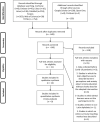The scope of dental education during COVID-19 pandemic: A systematic review
- PMID: 33759214
- PMCID: PMC8251403
- DOI: 10.1002/jdd.12587
The scope of dental education during COVID-19 pandemic: A systematic review
Abstract
Introduction: COVID-19 forced e-learning processes to develop abruptly and posed challenges to the educational infrastructure. Emergency Remote Teaching was designated to distinguish the new educational scheme. This concept involves production of online activities that may return to face-to-face format as soon as the isolation period ends.
Objective: From March through September of 2020, this systematic review attempted to elucidate experiences, benefits, and challenges enforced in dental education due to the pandemic, the learning technologies, and methods used to maintain education.
Methods: A literature search was conducted on Cochrane, Embase, Lilacs, Livivo, PubMed, Scopus, and Web of Science databases. Gray literature was also contemplated. Studies in which online teaching methods were described and dental learners were the subjects during pandemic were included.
Results: Learning technology, pedagogical model, knowledge gain, and dental learners' satisfaction and attitudes toward remote learning were assessed. The Joanna Briggs Institute JBI Critical Appraisal Checklist for Case Reports was applied as the methodological quality assessment to the 16 included studies. Assessments were related to demographic and historical characteristics of the participants, the intervention procedure, pre- and post-intervention descriptions, and identification of unanticipated events. All studies described the use of learning technology to ensure education continuity, and 15 studies highlighted the pedagogical model applied. Eight studies investigated knowledge gain while 12 searched the learners' satisfaction with online technologies.
Conclusion: The evidence suggests that learning technologies can support continuity in dental education. Reported problems include poor knowledge of faculty members on how to deal with technology, Internet connection, and content transition to online education.
Keywords: Covid-19; coronavirus; dental education; dentistry; e-learning; emergency remote teaching; systematic review.
© 2021 American Dental Education Association.
Conflict of interest statement
The authors declare no conflict of interest.
Figures
Similar articles
-
Challenges and Strategies Adopted for Remote Teaching of Biochemistry During the COVID-19 Pandemic: Protocol for a Scoping Review.JMIR Res Protoc. 2025 Jan 31;14:e59552. doi: 10.2196/59552. JMIR Res Protoc. 2025. PMID: 39889289 Free PMC article.
-
Online learning developments in undergraduate medical education in response to the COVID-19 pandemic: A BEME systematic review: BEME Guide No. 69.Med Teach. 2022 Feb;44(2):109-129. doi: 10.1080/0142159X.2021.1992373. Epub 2021 Oct 28. Med Teach. 2022. PMID: 34709949
-
COVID-19 pandemic and emergency remote education practices: Effects on dentistry students.Niger J Clin Pract. 2022 May;25(5):621-629. doi: 10.4103/njcp.njcp_1564_21. Niger J Clin Pract. 2022. PMID: 35593604
-
Distance learning in clinical medical education amid COVID-19 pandemic in Jordan: current situation, challenges, and perspectives.BMC Med Educ. 2020 Oct 2;20(1):341. doi: 10.1186/s12909-020-02257-4. BMC Med Educ. 2020. PMID: 33008392 Free PMC article.
-
Student nurses' experiences of remote learning during Covid-19 pandemic: A qualitative evidence synthesis.J Adv Nurs. 2024 Jul;80(7):2614-2628. doi: 10.1111/jan.15887. Epub 2023 Oct 3. J Adv Nurs. 2024. PMID: 37788086 Review.
Cited by
-
Enhancing Dental Education: Impact of Remote Teaching on Dental Students' Academic Performance in Orthodontics-A Pilot Study.J Med Educ Curric Dev. 2024 Nov 3;11:23821205241293488. doi: 10.1177/23821205241293488. eCollection 2024 Jan-Dec. J Med Educ Curric Dev. 2024. PMID: 39497905 Free PMC article.
-
Teledentistry Applied to Health and Education Outcomes: Evidence Gap Map.J Med Internet Res. 2024 Nov 27;26:e60590. doi: 10.2196/60590. J Med Internet Res. 2024. PMID: 39602783 Free PMC article. Review.
-
Comparison of light microscopy and digital microscopy for learning oral pathology practicals among second year dental students.J Dent Sci. 2024 Oct;19(4):2135-2139. doi: 10.1016/j.jds.2024.03.022. Epub 2024 Mar 30. J Dent Sci. 2024. PMID: 39347058 Free PMC article.
-
Intention of Collaboration among Dental Students during the COVID-19 Pandemic.Dent J (Basel). 2022 Mar 8;10(3):40. doi: 10.3390/dj10030040. Dent J (Basel). 2022. PMID: 35323242 Free PMC article.
-
The Dental Educational Environment of Online and Blended Learning during COVID-19, and the Impact on the Future of Dental Education.Dent J (Basel). 2023 Feb 7;11(2):41. doi: 10.3390/dj11020041. Dent J (Basel). 2023. PMID: 36826186 Free PMC article.
References
-
- Dong E, Du H, Gardner L. COVID‐19 dashboard by the Center for Systems Science and Engineering (CSSE) at Johns Hopkins University (JHU). Lancet Inf Dis. 2020;19:533‐534. - PubMed
-
- COVID‐19 educational disruption and response. UNESCO. 2020 Available at: https://en.unesco.org/covid19/educationresponse. Accessed October 15 2020.
-
- Iyer P, Aziz K, Ojcius DM. Impact of COVID‐19 on dental education in the United States. J Dent Educ. 2020;84(6):718‐722. - PubMed
-
- Joye C, Moreira M, Rocha S. Distance education or emergency remote educational activity: in search of the missing link of school education in times of COVID‐19. Res Soc Dev. 2020;9(7):e521974299.
-
- Krasna M, Bratina T. E‐learning materials for social science students. Probl Educ 21st Cent. 2014;61:77‐87.
Publication types
MeSH terms
LinkOut - more resources
Full Text Sources
Other Literature Sources
Medical


